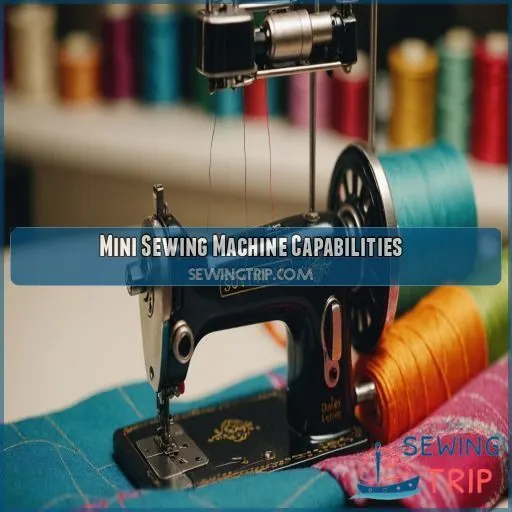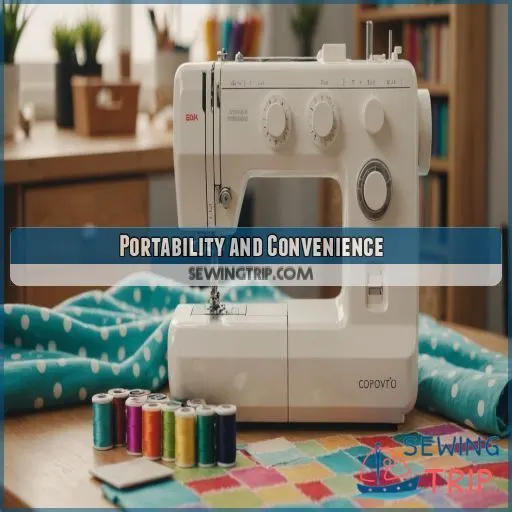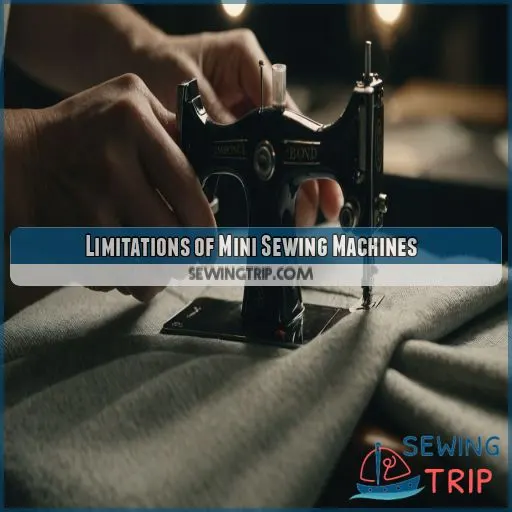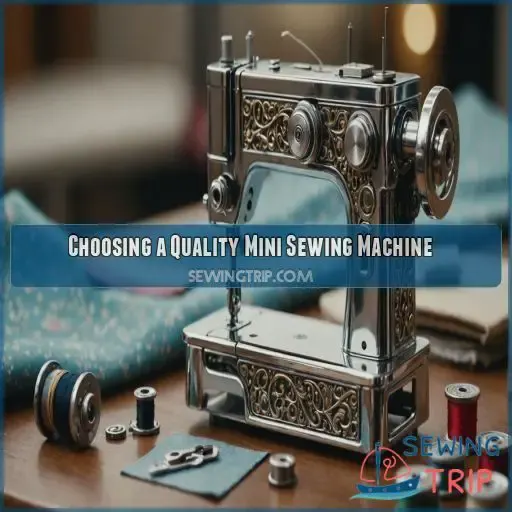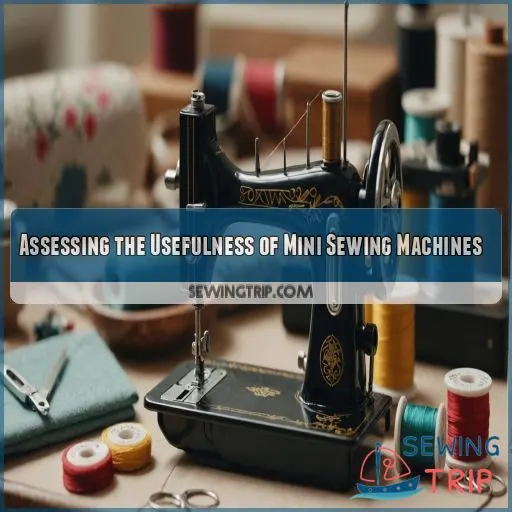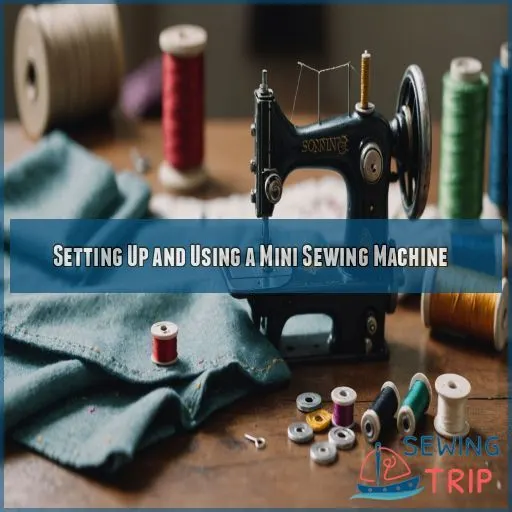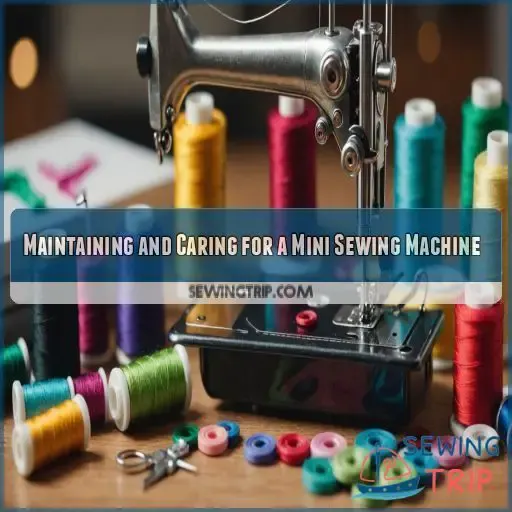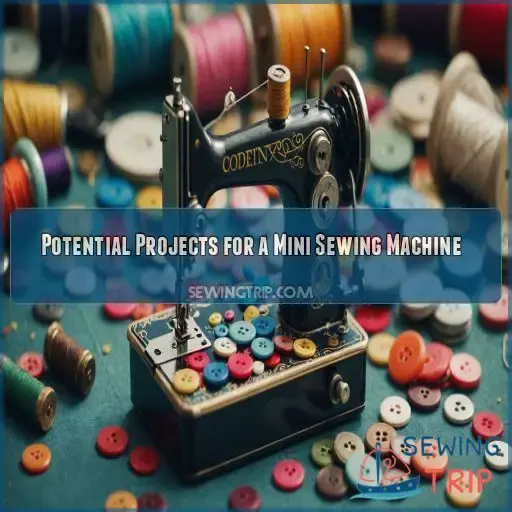This site is supported by our readers. We may earn a commission, at no cost to you, if you purchase through links.
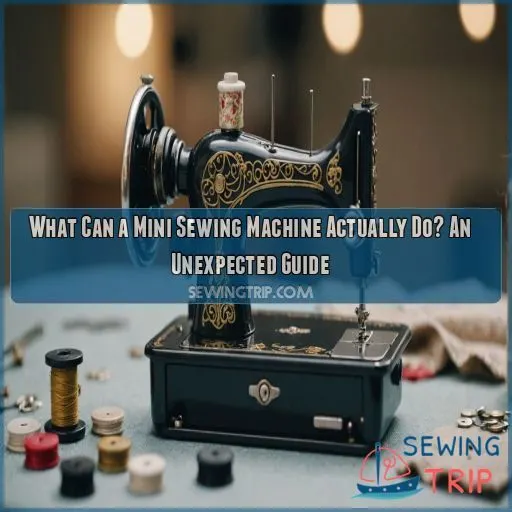
Their main functionality is the straight stitch, but you can still secure your stitches by backstitching at the start and end. This makes them suitable for tasks like hemming pants, reattaching buttons, and mending small rips.
Their lightweight, battery-powered design makes them super portable too – ideal for on-the-go crafting or quick repairs while traveling.
Just don’t expect them to tackle thick fabrics or complex projects. But for simple DIY fixes and easy accessory making, a mini sewing machine can be a real lifesaver.
Table Of Contents
- Key Takeaways
- Mini Sewing Machine Capabilities
- Portability and Convenience
- Limitations of Mini Sewing Machines
- Choosing a Quality Mini Sewing Machine
- Assessing the Usefulness of Mini Sewing Machines
- Setting Up and Using a Mini Sewing Machine
- Maintaining and Caring for a Mini Sewing Machine
- Potential Projects for a Mini Sewing Machine
- Frequently Asked Questions (FAQs)
- Conclusion
Key Takeaways
- Don’t underestimate the power of your mini sewing machine – it’s a handy sidekick that can tackle basic tasks like hemming pants, reattaching buttons, and whipping up quick crafty accessories. Just remember, it’s not built for heavy-duty projects, so stick to lightweight fabrics and simple designs.
- Your mini machine’s portability and battery-powered convenience make it a dream come true for on-the-go sewers. Toss it in your bag and unleash your inner crafty genius anywhere, from hemming a pair of jeans at the coffee shop to personalizing your luggage mid-trip.
- When shopping for a mini sewing machine, don’t be tempted by suspiciously cheap deals – those bargain basement models often hide shoddy craftsmanship. Do your research, read reviews, and invest in a reliable brand that will have your back for the long haul.
- Sure, your mini sewing machine may lack advanced features like a reverse stitch, but that doesn’t mean it’s a one-trick pony. You can still find mini sewing machines with reverse stitch capabilities that are compact and easy to use. With a steady hand and a bit of practice, you’ll be sewing like a pro, securing your stitches with a simple backstitch and tackling basic alterations and craft projects with ease.
Mini Sewing Machine Capabilities
Mini sewing machines may seem limited, but they can actually tackle a surprising range of basic sewing tasks.
While they lack advanced features like a reverse stitch, these compact machines make quick work of simple projects.
They are ideal for tasks like hemming pants or crafting small accessories.
Straight Stitch Function
The straight stitch is the mini sewing machine’s bread and butter.
Whether you’re hemming pants or quilting fabric scraps, this trusty stitch will get the job done.
Just mind the tension – too tight and your fabric might pucker, too loose and your seam could unravel.
With a steady hand, you’ll be sewing like a pro in no time.
No Reverse Stitch
Don’t fret about the lack of a reverse stitch.
You can secure your stitches just fine by backstitching at the start and end.
Sure, it’s not as seamless as a full-size machine, but with a little practice, you’ll get the hang of it.
Just focus on keeping those stitches nice and tidy.
Basic Sewing Tasks
A mini sewing machine is perfect for tackling basic sewing tasks.
It’s ideal for tasks like hemming pants, reattaching loose buttons, or mending small tears in your clothes.
With a mini sewing machine, you can complete these tasks with ease, making it perfect for simple alterations and basic craft projects when you don’t need advanced capabilities.
To use it, simply thread it up, position the fabric, and let your mini machine work its magic.
Portability and Convenience
Mini sewing machines are designed with portability and convenience in mind.
Their lightweight, compact build and battery power make them a breeze to tote around.
Whether you’re crafting on the go or taking your sewing on vacation, these machines are perfect for the task.
Lightweight and Compact Design
The mini sewing machine is feather-light and palm-sized, making it easy to carry around.
Its compact design makes it a breeze to tote around, whether you’re working on sewing projects at home or on the go.
This portable powerhouse lets you sew on the go with ease, making it perfect for tasks like hemming pants on the road or whipping up quick sewing projects.
Bye-bye, bulky machines – this mini sewing machine is the perfect solution for those who want to sew without the hassle of a large machine.
Battery Power
Your mini sewing machine’s battery power offers impressive portability. With just a few hours of charging, you can sew on-the-go without pesky cords.
When choosing a mini sewing machine, consider the following features for optimal convenience:
- Long-lasting lithium-ion batteries for extended use.
- Quick charging times to get you back to stitching fast.
- Dual power options – battery and AC adapter.
- Easy battery replacement for continued convenience.
Suitable for Travel and Crafting
This compact powerhouse is the perfect travel companion, making quick work of various tasks.
It’s great for hemming pants, patching a torn backpack, or whipping up on-the-go DIY accessories.
You can also tackle craft projects with ease, from embellishing a plain tote to personalizing your luggage.
Embrace the freedom of portable sewing anytime, anywhere.
Limitations of Mini Sewing Machines
Mini sewing machines offer portability and convenience. They are great for handling basic tasks.
However, their limited capabilities may leave you feeling frustrated. These petite machines have a small workspace and lack advanced features, making them unsuitable for more complex sewing projects.
Limited Fabric Compatibility
Mini sewing machines have limitations. While they can handle simple fabrics like cotton and polyester, they may not be suitable for all types of materials.
They may struggle with thick denim, leather, or densely-woven materials due to their delicate nature. These petite machines are not designed to handle heavy-duty or thick fabrics.
To get the best results, pay close attention to the fabric tension. Sticking to lightweight options is your best bet, as they are less likely to cause issues with the machine.
Small Workspace
Working with mini sewing machines can be a challenge due to the small workspace. This limited space can make it difficult to maneuver bulky fabrics.
The process of sewing with these machines can be compared to a ballet, where you have to carefully move your pieces around the tight confines of the workspace.
However, with nimble fingers and a can-do attitude, you can still achieve great results even with a small workspace.
Lack of Advanced Features
Don’t expect your mini sewing machine to handle complex projects like quilting or embroidery – its limited features just won’t cut it.
With just a straight stitch and no reverse, you’re stuck with basic tasks like hemming and light crafting. Sure, it’s portable and affordable, but it’s no replacement for a full-sized sewing machine.
Here are some key limitations to consider:
- No Buttonholes or Zippers
- Limited Stitch Options
- Lack of Quilting/Embroidery Functions
Choosing a Quality Mini Sewing Machine
When scouting for your perfect mini sewing machine, you’ll want to weigh the price and features carefully.
Don’t be fooled by suspiciously cheap knockoffs – take the time to find a quality model that will actually get the job done.
Comparing Amazon and Aldi Models
When it comes to choosing a mini sewing machine, you might immediately think of the popular option from Amazon. This model is known for working like a charm, making it a top choice for many.
However, don’t overlook the alternative option from Aldi. Although it may look suspicious at first, the Aldi version might have a sneaky hack that allows it to sew just as well as the Amazon model.
To make an informed decision, it’s essential to do your research and compare the features and benefits of each option. This will help you land the right mini sewing machine for your specific needs.
Assessing Price and Features
When picking a mini sewing machine, carefully weigh the price versus the features like those found in beginner-friendly mechanical models. This is an important consideration to ensure you get the right machine for your needs.
While the cheapest options may seem tempting, consider what you need from your mini sewing machine. Do you need just the basics, or do you crave more bells and whistles?
A few extra bucks could get you a model with greater capabilities.
Avoiding Subpar Quality
Sidestep sewing machine subpar quality by scrutinizing reviews. Steer clear of too-good-to-be-true bargains – they often hide shoddy craftsmanship. Instead, splurge on a reputable brand that guarantees satisfaction.
After all, your mini machine should be a trusty steed, not a temperamental thorn in your side!
Here are some tips to keep in mind:
- Read reviews carefully for red flags.
- Beware suspiciously low prices – they mask inferior components.
- Invest in a reliable brand with a solid warranty.
Assessing the Usefulness of Mini Sewing Machines
Are you considering a mini sewing machine but unsure if it’s worth the investment?
Determining whether a mini sewing machine meets your needs comes down to understanding its capabilities and limitations.
While these compact machines handle basic tasks, they may not be suitable for more complex projects.
Suitability for Basic Sewing
If you’re after a basic sewing machine for simple tasks like hemming pants or mending rips, a mini sewing machine might just fit the bill. These compact wonders can handle straightforward alterations and crafty projects with ease.
Just don’t expect them to tackle complex stitching or heavy-duty fabrics – they’re more like sewing sidekicks than main players.
| Task | Suitable | Not Suitable |
|---|---|---|
| Hemming | ||
| Mending | ||
| Crafting | ||
| Denim | ||
| Stretchy Fabrics |
Unsuitability for Complex Projects
Mini sewing machines have their limits. They just aren’t cut out for complex projects.
Thick fabrics, garment construction, and multiple layers are tricky tasks that are beyond their humble capabilities.
Stick to simple hemlines and easy crafts, and avoid getting in over your head with intricate designs that’ll only leave you frustrated.
These little machines have their limits, but hey, at least they’re easy to store.
Considering Budget and Storage Needs
If you’ve got a tiny apartment and a tight budget, you’re likely looking for ways to save space and cut costs.
A mini sewing machine is worth considering if you’re strapped for room and cash. It may not tackle complex projects, but for simple DIY fixes and crafty creations, it packs a punch.
The benefits of a mini sewing machine include not busting your wallet or hogging precious storage space.
Setting Up and Using a Mini Sewing Machine
First, you’ll need to prepare the machine for sewing. This involves three main steps:
- Thread the top spindle: This is the first step in preparing your machine.
- Wind the bobbin: After threading the top spindle, you’ll need to wind the bobbin.
- Thread the machine: Finally, you’ll need to thread the machine itself.
Once you’ve completed these steps, you can move on to positioning your fabric correctly. This is a crucial step in ensuring that your sewing project turns out as desired.
With your fabric in place, you’re now ready to start sewing. Simply follow the manufacturer’s instructions for operating the machine, and you’ll be on your way to creating your desired project.
Threading the Machine
Start by finding the top spindle – that’s where the spool of thread sits.
Unwind a bit of thread, then feed it down through the tension discs, around the take-up lever, and finally through the eye of the needle.
Just make sure everything’s taut and you’re good to stitch.
Winding the Bobbin
Winding that bobbin is a breeze – just grab the empty spool, pop it into the bobbin winder, and let ‘er rip!
Be sure to use the right bobbin size for your machine.
Keep an eye on the tension as you wind. Too loose and it’ll be a tangled mess, too tight and it’ll snap.
Get this part right, and the rest of your sewing is smooth sailing.
Positioning the Fabric Correctly
Carefully position your fabric, aligning the edges and ensuring adequate seam allowance.
Gently feed the fabric into the machine, keeping it taut yet relaxed. Adjust the needle position as needed to maintain proper alignment.
With a little practice, you’ll be sewing like a pro, guiding the fabric smoothly through each stitch. Just take it one step at a time, and you’ll be creating your mini masterpieces in no time!
Maintaining and Caring for a Mini Sewing Machine
To keep your mini sewing machine in tip-top shape, follow these simple steps:
Regularly clean the machine to ensure it continues to function properly.
Adjust the tension as needed to prevent any issues with your stitches.
Always unplug the machine when you’re done using it – safety first.
Cleaning and Adjusting Tension
After each sewing session, give your mini machine a quick once-over.
Gently brush away any trapped lint or threads – this helps maintain smooth operation.
Tweaking the tension dials lets you fine-tune your stitches for different fabrics. Take it slow and test on scrap to find that Goldilocks-level tension that’s just right.
Handling Needles Safely
Handle those pesky sewing needles with care, my friend. Treat ’em like tiny, sharp sidekicks – with respect, not recklessness.
Store them safely in a pincushion or magnetic strip, and dispose of broken ones properly.
Different needle types work for different fabrics, so keep an eye on those little guys. Safety first, sewing second!
Unplugging When Not in Use
This simple step can go a long way in preventing electrical hazards and extending the life of your machine.
Plus, it’s an easy way to save power and reduce your carbon footprint.
Your sewing companion will thank you for the extra TLC.
Potential Projects for a Mini Sewing Machine
Mini sewing machines may be compact, but don’t underestimate their mighty capabilities.
From hemming pants and skirts to crafting simple yet stylish accessories, these pint-sized powerhouses can handle all sorts of quick, practical sewing projects around the home.
Get ready to tap into your inner fashion designer with your mini marvel.
Hemming Pants and Skirts
Hemming pants and skirts is an easy win for your mini sewing machine.
Simply slip the hem under the presser foot, take it slow, and let the machine do the work.
Play with stitch length to get the perfect finish on lightweight or stretchy fabrics.
No pins required – just measure, fold, and sew. Easy peasy!
Crafting Simple Accessories
With your mini sewing machine, the possibilities for crafty accessories are endless.
Why not whip up some DIY jewelry using fabric scraps? This is a great way to get creative and make something unique.
Or sew up a charming little pouch to stash your sewing tools. The compact size of your mini machine makes these upcycled crafts a breeze.
Get creative – your mini machine is begging to bring your accessories visions to life.
Adjusting Clothing Fit
Your mini sewing machine can be a lifesaver for adjusting clothing fit.
With a mini sewing machine, you can make several quick adjustments to transform an ill-fitting garment into a perfectly customized piece.
You can whip up a quick hem, take in those gaping seams, or shorten those sleeves – it’s amazing how a few small tweaks can make a big difference.
With a little practice, you’ll be altering like a pro in no time.
Frequently Asked Questions (FAQs)
What is the use of mini sewing machine?
A mini sewing machine’s portability and battery-power make it handy for basic tasks, like the Sunbeam Mini.
It’s suitable for tasks like hemming clothes or crafting small items.
However, its limited capabilities may not suit more complex projects.
It’s an affordable, compact option for on-the-go sewing needs.
What can you make with a small sewing machine?
A mini sewing machine is suitable for simple sewing projects.
It’s ideal for tasks like hemming pants, stitching crafts, and making basic alterations.
However, it’s not designed for complex tasks and won’t handle them like a full-size machine.
Is it worth buying a mini sewing machine?
Considering a mini sewing machine? Stop!
It might seem handy, but these pint-sized wonders often underwhelm.
Unless you’re a minimalist on a shoestring, a full-size machine is worth the investment – it’ll grow with your skills and projects.
Can a mini sewing machine sew jeans?
Sewing jeans with a mini machine isn’t recommended. Its limited power and small size make it struggle with thick denim fabrics.
While you could technically sew light denim, it’d be a tedious process.
Stick to lighter weight projects for best results with a mini sewing machine.
Can a mini sewing machine sew through thick fabrics?
Mini sewing machines have their limitations. They are not built for sewing thick fabrics.
They are more suited for lightweight materials like cotton or polyester.
If you need to tackle heavy-duty stuff, you’d be better off with a full-sized sewing machine.
How durable are mini sewing machines over time?
Mini sewing machines can last for years, but their durability depends on how often you use them.
Treat it gently, store it properly, and it’ll chug along merrily, making your on-the-go sewing a breeze for the long haul.
Do mini sewing machines have adjustable stitch length?
Most mini sewing machines allow you to adjust the stitch length, giving you more control over the final look.
This handy feature lets you customize your sewing projects to perfection.
Can a mini sewing machine handle quilting projects?
Quilting with a mini sewing machine is a challenging task.
It just ain’t gonna work, my friend. These petite machines simply don’t have the muscle for heavy-duty quilting projects.
Time to shelve that dream and stick to simpler sewing tasks instead.
What accessories are typically included with mini sewing machines?
Mini sewing machines typically come bundled with a handy accessory kit.
This kit usually includes extra needles, thread, bobbins, and a seam ripper.
These accessories provide everything you need to tackle basic sewing tasks with ease on the go.
Conclusion
Diminutive yet dynamic, these darling mini sewing machines deliver delightful functionality for your fundamental fabric fixes.
While unfit for unwieldy undertakings, these wondrous workhorses wholeheartedly welcome hemming, mending, and modifying.
For the modern maven on the move, a mini sewing machine’s mighty mobility and modest maintenance make it a must-have for your what-can-a-mini-sewing-machine-do arsenal.

